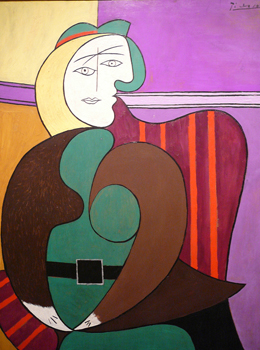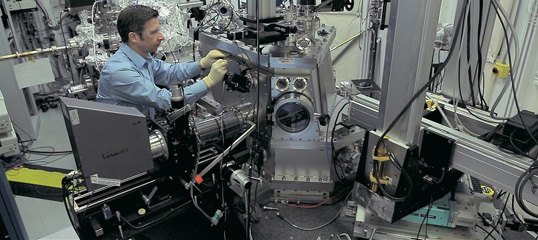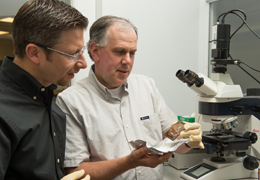Daguerreotypes, the earliest photographs ever taken, are fading under the concerned eyes of museum curators. To preserve these historic snapshots, scientists are probing their elemental makeup. The universal chemistry of corrosion they’ve identified could help save the pictures—and safeguard electronics of the future.
Volker Rose, a physicist at Argonne National Laboratory in Illinois, uses powerful X-rays to observe chemical changes in historic artwork. He began with Picasso. Teaming up with historians from the Art Institute of Chicago, Rose analyzed zinc oxide in Picasso’s works. He found that the artist had used common house paint, not traditional oil paints, to create shiny smooth whites in famous pieces like The Red Armchair (below). The aging pigments foretell the fates of modern nanomaterials in cellphones and solar panels, which also rely on zinc oxide. Studying how the paint weathered, says Rose, can tell us how newer technology will stand the test of time.
Rose then collaborated with the Smithsonian Institution to analyze corrosion on 150-year-old daguerreotypes. Rose and his colleagues published a paper last year on the composition of zinc white in Cubist paintings. He presented his work on the chemistry of these iconic paints and daguerreotypes at the February 2014 meeting of the American Association for the Advancement of Science in Chicago. After the symposium, he joined SciCom’s Jyoti Madhusoodanan for a penetrating discussion.
What can you see with these high-power X-rays that you can’t with other technologies?
X-rays can have different energies, from very low to very high. There is a threshold around 3,000 keV [kiloelectron volts]—everything that’s higher is called a hard X-ray. The higher the energy, the deeper you can shoot into a sample and extract information. The material reacts by sending out fingerprints of secondary radiation that we pick up. A fingerprint is unique to each element. For instance, the radiation from a cobalt cluster is different from the one from an iron cluster.
The other advantage, specific to the hard X-ray nanoprobe, is that we can focus the X-rays on a pixel. In principle, we can distinguish between different oxidation states of iron, zinc, copper and so on. Synchrotron technology [using intense X-rays spit out by powerful, circular particle accelerators] opens up a totally new avenue for studying these materials.
It’s like a new way of looking at the same painting again.
Yes. It’s actually looking deeper, picking up information that was not accessible before. The technology used until now didn’t have the ability to study at this small scale.
 What was it like to work with these paintings?
What was it like to work with these paintings?
We didn’t study the whole painting. The Art Institute took the samples. We were interested in looking into one single pigment, so we didn’t need the whole painting—just a tiny sample, like the head of a pin. The pieces are almost like dust.
For a lot of our research, we make our own samples, hundreds or thousands if needed. So if something happens to them, it’s no big deal. For the Picasso sample (bright white pigments, left), the number was drastically reduced. We are also studying extremely precious samples in other areas. I had one researcher come to me to study one particle of stardust, 10 microns [0.01 millimeters] large.
But from a chemical perspective, we were just studying zinc white here, a piece of paint. Zinc oxide is something we study all the time for its potential as a display material in solar cells, or as a potential replacement for all the silicon electronics we currently use.
Is there something you can extrapolate from the painting to modern technology?
Yes, that’s an important point. People like you, people who pay taxes, might ask why a Department of Energy laboratory is studying Picasso's paint.
We learn something about zinc oxide that has applications in areas that are not cultural heritage at all. For example, the impurities in zinc oxide in this sample tell us how these might behave in advanced electronics.
A lot of physicists study zinc oxide as a so-called dilute semiconductor—in small magnets for memory in computers, for example. What they might not know is that they’re also studying Picasso paint at the same time. It’s the same material.
Your work helped settle a long-standing question about the kind of paint Picasso used. Do you think there are other controversies you might be able to resolve?
I think we can help support other kinds of research by art historians. We have to be careful, though. All the science we do will always be just one building block. We cannot expect to put a painting into a machine and out comes a paper that tells me who the artist was.
Has your perspective of art changed after you started these projects?
Absolutely. I have gained the ability to read a little bit more, so even with my eyes I try to look below the surface. I see paintings differently now. I ask myself more questions; I try to form a closer relationship to art.
What kinds of questions do you ask yourself?
That depends on the painting. As scientists we are trained to think and operate in a certain way. It would be wrong to say science can’t touch your feelings—like when you get a result after hundreds of hours of trying. I can get very emotional about science, in a good and bad sense. But in science, we want effects in terms of numbers and graphs. When you stand in front of a painting, that’s exactly what you don’t want. You don’t want to analyze. You want to receive it without filtering. This is about two different aspects of life.
"We cannot expect to put a painting into a machine and out comes a paper that tells me who the artist was."
Was there a particular moment during this work when your perspectives about art changed?
One of the first times I visited the Art Institute, I had an experience few other visitors get. I went to the back, where I saw a painting that was not in its frame. You could see the artist had scribbled on the back of the canvas. When I saw that, I felt much more connected and closer to the artist, as though I was standing next to him as he was painting and scribbling.
Is there a particular historical piece or artwork you want to study?
Maybe the back of the Constitution, to see if there’s something written there! It is hard to pick a dream project. I wouldn’t necessarily pick the Mona Lisa or something just because it’s cool. It’s not so much about a particular painting, but about learning and generalizing information. If we learn what’s going on in one daguerreotype, we can perhaps save hundreds or thousands of them.
After the Picasso analysis, you moved on to study daguerreotypes with the Smithsonian. Do you see yourself becoming a “cultural heritage scientist?”
It’s only a small part of what I do. As a scientist, I enjoy doing some stuff that is out of the normal. I try to apply what I know to different spheres. One of those spheres is cultural heritage, and I fell in love with it. Now I’m even contacted by people who have a Picasso at home and want us to work on it.
Will I be a cultural heritage scientist at some point? No, I will not be. I also have other interests. The underlying drive for me is to push the boundaries of X-ray microscopy—[whether it is] in cultural heritage, biology, magnets, or to shrink your cellphone and make it faster.
Have you applied the information from these projects to other studies?
Yes, absolutely. For example, in this daguerreotype work we studied corrosion by sulfide particles from the atmosphere. It has direct implications for other materials, like the circuitry in cell phones, or [metals in] oil pipelines. Pipelines can get destroyed by the same kind of sulfur corrosion that goes on in the daguerreotype.
So when we study how sulfur diffuses into voids beneath the surface in this daguerreotype, we are seeing the same processes happening in an oil pipeline. Since the daguerreotype is 150 years old, it allows us to fast-forward what we would usually have to simulate.
And if you know the chemistry, you can apply this data from art to nanotechnology?
That’s something we can do. With the zinc oxide, we can learn to make better displays. For the daguerreotypes, we could help save oil pipelines, nano-electronics, or anything that corrodes due to sulfur.
Although the investigation of that particular paint chip is done, extending this work into other fields will go on for years. This is not a project that starts and ends. It branches like a tree. Along the way you encounter other projects where you can use this knowledge.
For instance, the people who study zinc oxide for magnetic data storage might learn something about why their spectra look the way they do if they read our paper. They could learn about the role of impurities in zinc oxide in their samples. Many scientists try to minimize the complexity of what they’re studying, so they might disregard such impurities. But with this data, we can tell if there’s something inside the impurities that might influence their calculations. We can put [that knowledge] into designing better materials.
So it is taking the knowledge of what is, and applying it to what we want to make.
Yes, the same way people might say that when we design airplanes, we learn from nature. When we design nanomaterials, we can learn from the past to design smarter materials.
You said, “If they read the paper, they might learn about this.” Do you feel scientists working on new materials are unlikely to read these papers?
One of the problems with cultural heritage and science is that they don’t usually publish in the same journals. So the information might be out there, but people are not reading it. There’s not a particular area where work at this intersection is published. It’s either A or B, and it makes some results invisible.
Is this a barrier between scientists and art historians?
There’s certainly a part of that, and it goes in both directions. If you want an interface of science and art, it requires communication and willingness to learn about the other side. The really difficult part of science and art is creativity. So in that sense, there’s a lot of art in science, and science in the arts.
Do you see the need for a new field?
What we need is a change in mindset. Nanotechnology is a relatively new field, but that’s really where everything comes together—physics, chemistry, biology, art. Everything merges.
____________________
© 2014 Jyoti Madhusoodanan
Jyoti showcases her journalism work here: smjyoti.com
Picasso's The Red Armchair: Image courtesy of Flickr user tacvbo



